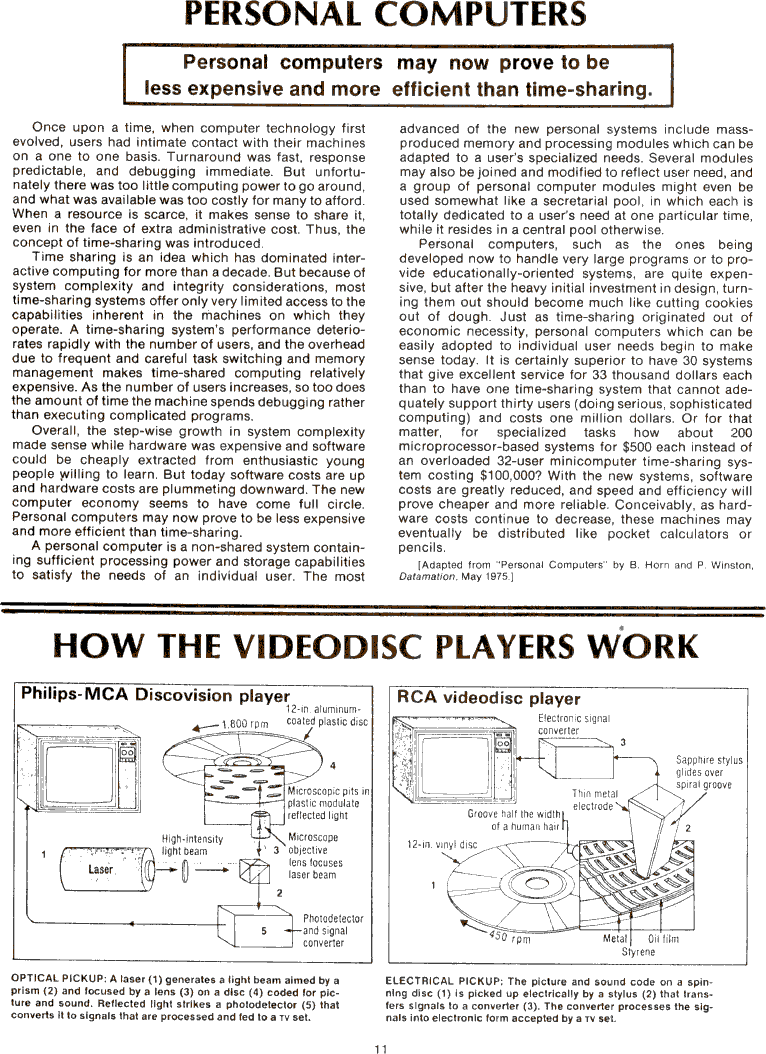The Best of Creative Computing Volume 2 (published 1977)
Personal Computers (Personal computers may now prove to be less expensive and more efficient then time-sharing, adapted from Personal Computers by B. Horn and P. Winston, Datamation, May 1975)

PERSONAL COMPUTERS
Personal computers may now prove to be less expensive and more efficient that
time-sharing.
Once upon a time, when computer technology first evolved, users had intimate
contact with their machines on a one to one basis. Turnaround was fast, response
predictable, and debugging immediate. But unfortunately there was too little
computing power to go around, and what was available was too costly for many to
afford. When a resource is scarce, it makes sense to share it, even in the face
of extra administrative cost. Thus, the concept of time-sharing was introduced.
Time sharing is an idea which has dominated interactive computing for more than
a decade. But because of system complexity and integrity considerations, most
time-sharing systems offer only very limited access to the capabilities inherent
in the machines on which they operate. A time-sharing system's performance
deteriorates rapidly with the number of users, and the overhead due to frequent
and careful task switching and memory management makes time-shared computing
relatively expensive. As the number of users increases, so too does the amount
of time the machine spends debugging rather than executing complicated programs.
Overall, the step-wise growth in system complexity made sense while hardware was
expensive and software could be cheaply extracted from enthusiastic young people
willing to learn. But today software costs are up and hardware costs are
plummeting downward. The new computer economy seems to have come full circle.
Personal computers may now prove to be less expensive and more efficient than
time-sharing.
A personal computer is a non-shared system containing sufficient processing
power and storage capabilities to satisfy the needs of an individual user. The
most advanced of the new personal systems include mass-produced memory and
processing modules which can be adapted to a user's specialized needs. Several
modules may also be joined and modified to reflect user need, and a group of
personal computer modules might even be used somewhat like a secretarial pool,
in which each is totally dedicated to a user's need at one particular time,
while it resides in a central pool otherwise.
Personal computers, such as the ones being developed now to handle very large
programs or to provide educationally-oriented systems, are quite expensive, but
after the heavy initial investment in design, turning them out should become
much like cutting cookies out of dough. Just as time-sharing originated out of
economic necessity, personal computers which can be easily adopted to individual
user needs begin to make sense today. It is certainly superior to have 30
systems that give excellent service for 33 thousand dollars each than to have
one time-sharing system that cannot adequately support thirty users (doing
serious, sophisticated computing) and costs one million dollars. Or for that
matter, for specialized tasks how about 200 microprocessor-based systems for
$500 each instead of an overloaded 32-user minicomputer time-sharing system
costing $100,000? With the new systems, software costs are greatly reduced, and
speed and efficiency will prove cheaper and more reliable. Conceivably, as
hardware costs continue to decrease, these machines may eventually be
distributed like pocket calculators or pencils.
[Adapted from "Personal Computers" by B. Horn and P. Winston, Datamation, May
1975.]
***
HOW THE VIDEODISC PLAYERS WORK
[image]
Philips-MCA Discovision player
1
Laser
High-intensity light beam
1,800 rpm
12-in. aluminum-coated plastic disc
4
Microscopic pits in plastic modulate reflected light
3
Microscope objective lens focuses laser beam
2
5
Photodetector and signal converter
OPTICAL PICKUP: A laser (1) generates a light beam aimed by a prism (2) and
focused by a lens (3) on a disc (4) coded for picture and sound. Reflected light
strikes a photodetector (5) that converts it to signals that are processed and
fed to a tv set.
[image]
RCA videodisc player
Electronic signal converter
3
Sapphire stylus glides over spiral groove
Thin metal electrode
2
Groove half the width of a human hair
12-in. vinyl disc
1
450 rpm
Metal
Oil film
Styrene
ELECTRICAL PICKUP: The picture and sound code on a spinning disc (1) is picked
up electrically by a stylus (2) that transfers signals to a converter (3). The
converter processes the signals into electronic form accepted by a tv set.
11


